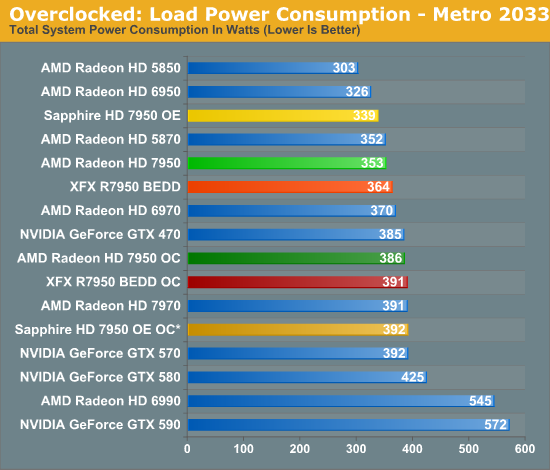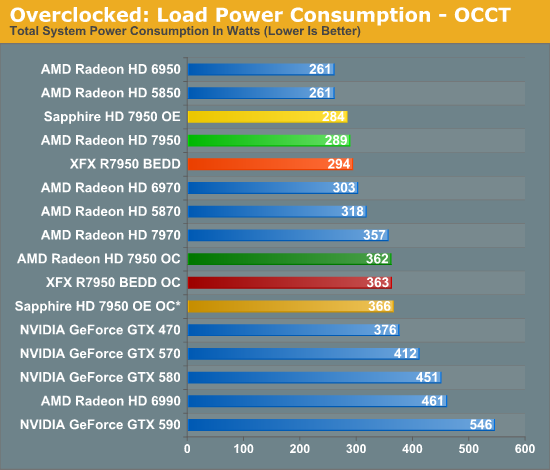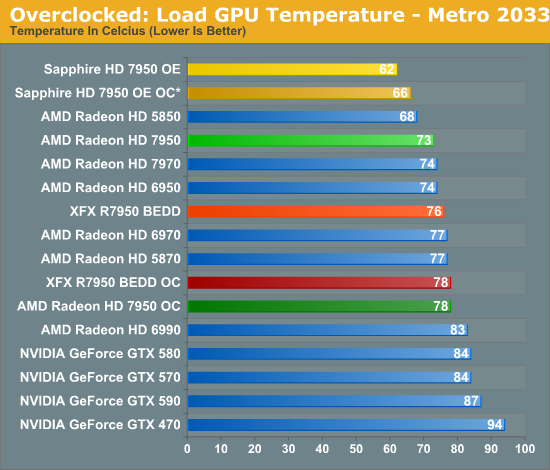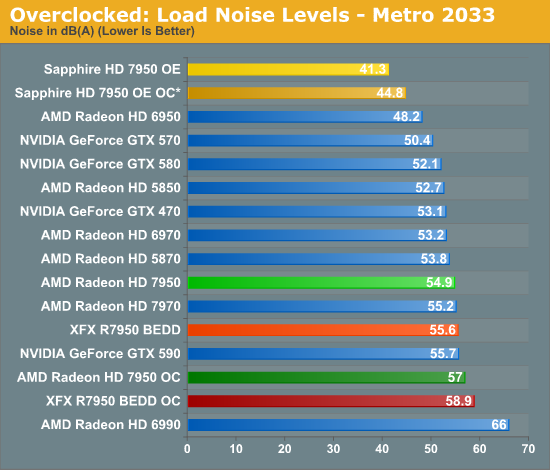AMD Radeon HD 7950 Review Feat. Sapphire & XFX: Sewing Up The High-End Market
by Ryan Smith on January 31, 2012 9:02 AM ESTOverclocking: Power, Temp, & Noise
In their marketing materials AMD is heavily pushing overclocking, and they have good reason to. With the 7970 we’ve established that Tahiti has quite a bit of overclocking headroom, and as the 7950 is clocked lower by default this opens up that headroom even further. Realistically AMD’s binning process means that the best clocking Tahiti GPUs are going to be allocated to the 7970 unless they have failed shaders, but even with that there’s quite a bit of potential on paper.
As with overclocking the 7970, our goal overclocking the 7950 is to see how much you can get for free; that is without any voltage adjustments. AMD’s reference PCBs are not particularly overbuilt for overclocking—cards like that will come later—so sticking to the reference voltage is the safest option, not to mention the easiest. With the 7970 we were able to get 200MHz (22%) overclocks without any voltage adjustment, and we’re hoping for the same out of the 7950.
With that said, we quickly ran into a wall on one card: the Sapphire 7950. Sapphire’s low VID of 0.993v may be great for temperature and noise at stock, but it’s not doing overclocking any favors. We only hit 950MHz at that voltage. As the Sapphire was the odd man out—every other card was at 1.093v—we did end up overvolting the Sapphire to 1.093v to see what it was capable of when put on similar footing as the rest of our cards.
After bringing up the voltage of our Sapphire card, all of our 7950s ended up overclocking to very similar levels. Our Sapphire and AMD cards topped out at 1025MHz core, a 225MHz (28%) overclock over a stock 7950 and a 125MHz (14%) overclock over the Sapphire’s factory overclock, while our XFX card reached 1050MHz, a 150MHz (17%) overclock beyond XFX’s factory overclock. Meanwhile the memory clocks on all of our cards topped out at 5.8GHz, beyond which we’d start seeing performance regressions from error correction on the memory bus.
| Radeon HD 7950 Overclocking | |||||
| AMD Radeon HD 7950 | Sapphire HD 7950 Overclock Edition | XFX R7950 BEDD | |||
| Shipping Core Clock | 800MHz | 900MHz | 900MHz | ||
| Shipping Memory Clock | 5GHz | 5GHz | 5.5GHz | ||
| Shipping Voltage | 1.093v | 0.993v | 1.093v | ||
| Overclock Core Clock | 1025MHz | 1025MHz | 1050MHz | ||
| Overclock Memory Clock | 5.8GHz | 5.8GHz | 5.8GHz | ||
| Overclock Voltage | 1.093v | 1.093v | 1.093v | ||
As you can imagine, with such similar overclocks, gaming performance on all 4 cards ended up being very similar. So we’ll get to gaming performance in a minute, while we’ll start with power, temperature, & noise.


Even though we’re not increasing the voltage on our AMD and XFX cards, merely overclocking them and raising the PowerTune limit to avoid throttling does drive the power consumption up. As is typical with heavily overclocked cards, overclocking quickly drives up power consumption and the 7950s are no exception. After overclocking power consumption is almost identical to the stock 7970, so while you can get 7970 performance you still need to pay the price with 7970 power consumption. Meanwhile it’s interesting to note that even with the extra 0.1v we’ve given the Sapphire card its final power consumption is only ever so slightly higher than the other 7950s, proving that voltage is the great equalizer in this case.


With the increase in power comes an increase in temperatures. The Sapphire card still does very well here staying in the low 70s even under OCCT, while the reference and XFX cards hit the high 70s under Metro and mid 80s under OCCT. As we’ve yet to really ascertain what the thermal limits are for Tahiti, it’s not clear whether there’s too much thermal headroom left for the GPU, particularly under OCCT.


Last but not least we have load noise. The Sapphire card is once more a stellar performer, and we still can’t get it above 50dB even with OCCT. Unfortunately the XFX 7950 BEDD has its biggest fallout yet—it may be able to overclock well, but at 64dB under OCCT the performance isn’t going to be worth the immense amount of noise it creates to move enough air to keep the GPU cool.










259 Comments
View All Comments
chizow - Saturday, February 4, 2012 - link
Well I'm not one to totally dismiss metrics like power consumption, thermals, noise but really those types of considerations are tertiary for anyone looking in this segment, especially when its very clear relative pricing is based on performance and performance only.Performance is primary, secondary considerations would be actual features (API, multi-mon, 3D, compute, etc.) and these fringe considerations like power, noise, heat a distant 3rd for anyone interested in this segment. It is more important for some people, but generally, performance is not the primary consideration for those people. Generally those who shop in this segment look at performance without compromise.
In any case, Nvidia's strategy for their flagship ASICs have always been big die since the G80 and from that they've generally derived their top two desktop SKUs and X2 parts. But on top of that, they also put these ASICs in their highly lucrative professional parts like Tesla and Quadro. This is not unlike Intel's strategy with their highest-end CPUs (Westmere, SB-E) where the highest-end parts are shared between their high-end server and enthusiast desktop platform.
AMD's strategy used to be "small die" after the R600 fiasco, where they would release a much smaller chip and still remain competitive through smaller process node and higher clock speeds with a halo X2 part made easier because of these smaller die sizes. But if you look at the die comparisons over the years, you can clearly see this small die strategy is getting away from them as well, as their chips have grown in size and power consumption through each generation.
There was always internal conflict over this "small die" decision though, but it looks to me like the "big die" folks are back in favor at AMD GPU as they realize they will never be able to beat Nvidia with a smaller die and higher clocks alone and aren't going to fetch a higher asking price based on just good looks and more attractive thermals.
Arnir69 - Saturday, February 4, 2012 - link
I was looking forward to 7950 but the perf jump from my 580 is negligible so I'm going to pass, was expecting more from AMD, loved their 6950 in cfx which was awesome value. If I was still running those there would be even less reason to buy 79xx. I agree with Chizow's point: Nothing new or exciting here, now looking at Kepler to shakeup 2012's high end graphics scene.chizow - Saturday, February 4, 2012 - link
Thanks, I knew there were reasonable minds out there that felt similarly. Reading through the comments there are definitely more who feel the same way, which is assuring, because I really don't want to see a $750 flagship card from Nvidia.It just seems there's a few unreasonable folks out there who just want to ignore the obvious along with mountains of historical data points that tells us what AMD has done here with Tahiti pricing is unprecedented and frankly, quite shocking.
RussianSensation - Saturday, September 8, 2012 - link
"If GK110 beats the 7970 by 20-25% and costs only $500, AMD execs will be jumping out of windows."GK104 $500 ended up losing the performance and price/performance crown to the HD7970 OC on air and on water. Looks like your prediction didn't come true this round.
HaydenOscar - Tuesday, January 31, 2012 - link
"[partner cards]"In the middle of the first page. :)
prime2515103 - Tuesday, January 31, 2012 - link
"On January 20st..."Paragraph one, line two, sentence two.
jjj - Tuesday, January 31, 2012 - link
with the 6970 starting at 300$,this one is a tough sellcasteve - Tuesday, January 31, 2012 - link
looks like a cut/paste error creeped in. :)casteve - Tuesday, January 31, 2012 - link
sapphire pricing in the table needs to be updated, too.Ryan Smith - Tuesday, January 31, 2012 - link
Please reload. It should already be fixed.